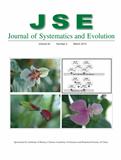Yan-Nan LI, Lei XIE, Jin-Yu LI, Zhi-Xiang ZHANG
Euonymus, a cosmopolitan genus of the family Celastraceae, has its species diversity centered in East Asia. It exhibits a complex pattern of morphological variation, making its taxonomy difficult. Monophyly of the genus remains uncertain, and the evolutionary implications of the infrageneric division and delimitation of many species are debatable. In this study, we sampled a total of 62 accessions representing 48 species/taxa covering a broad range of diversity of the genus and its allies. We first investigated the phylogeny of Euonymus using DNA sequences of multiple nuclear and plastid markers, and then used this phylogeny to discuss the circumscription and classification of the genus in combination with evolution of fruit characters, which has been used as an important criterion for the generic subdivision. The resultant data revealed the monophyly of Euonymus sensu lato with inclusion of Glyptopetalum, resolved the major lines of phylogeny of the genus, and clarified the echinate and winged capsules each as lineage-specific. Therefore, among the five sections accepted by Flora of China, only Sect. Echinococcus(with spiny fruits) and Sect. Kalonymus (with winged fruits) correspond to the molecular grouping. The globose capsule may represent an ancestral character state, and the other types of fruits, that is, the shallowly to deeply lobed capsules, may belong to a broad range of continuous variation derived from the globose.

